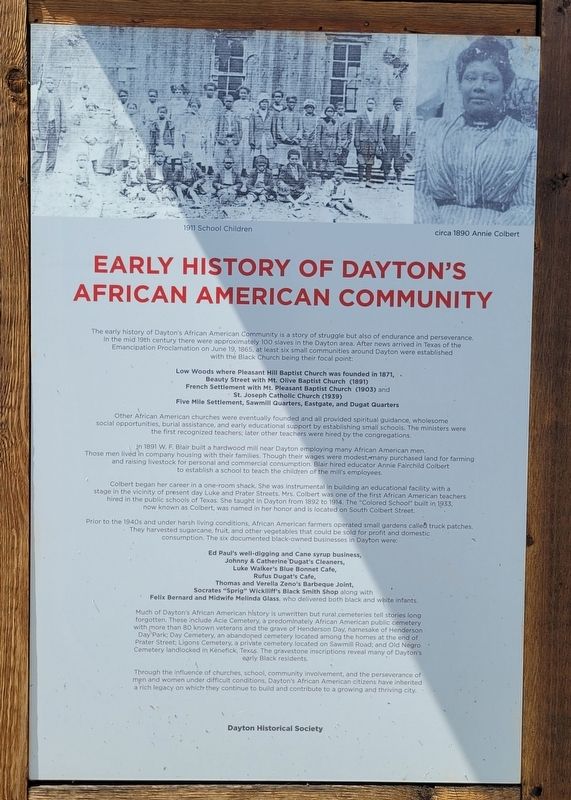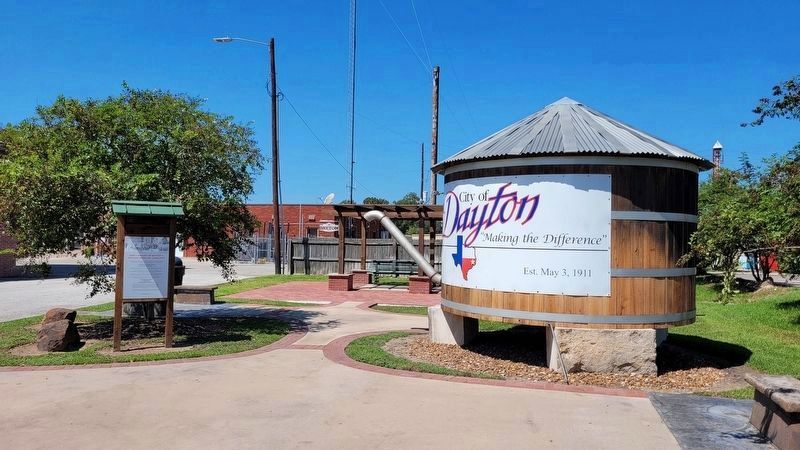Dayton in Liberty County, Texas — The American South (West South Central)
Early History of Dayton's African American Community
Inscription.
The early history of Dayton's African American Community is a story of struggle but also of endurance and perseverance. In the mid 19th century there were approximately 100 slaves in the Dayton area. After news arrived in Texas of the Emancipation Proclamation on June 19, 1865, at least six small communities around Dayton were established with the Black Church being their focal point:
Beauty Street with Mt. Olive Baptist Church (1891)
French Settlement with Mt. Pleasant Baptist Church (1903) and
St. Joseph Catholic Church (1939)
Five Mile Settlement, Sawmill Quarters, Eastgate, and Dugat Quarters
Other African American churches were eventually founded and all provided spiritual guidance, wholesome social opportunities, burial assistance, and early educational support by establishing small schools. The ministers were the first recognized teachers; later other teachers were hired by the congregations.
In 1891 W.F. Blair built a hardwood mill near Dayton employing many African American men. Those men lived in company housing with their families. Though their wages were modest, many purchased land for farming and raising livestock for personal and commercial consumption. Blair hired educator Annie Fairchild Colbert to establish a school to teach the children of the mill's employees.
Colbert began her career in a one-room shack. She was instrumental in building an educational facility with a stage in the vicinity of present day Luke and Prater Streets. Mrs. Colbert was one of the first African American teachers hired in the public schools of Texas. She taught in Dayton from 1892 to 1914. The "Colored School" built in 1933, now known as Colbert, was named in her honor and is located on South Colbert Street.
Prior to the 1940s and under harsh living conditions, African American farmers operated small gardens called truck patches. They harvested sugarcane, fruit, and other vegetables that could be sold for profit and domestic consumption. The six documented black-owned businesses in Dayton were:
Johnny & Catherine Dugat's Cleaners,
Luke Walker's Blue Bonnet Cafe,
Rufus Dugat's Cafe,
Thomas and Verella Zeno's Barbeque Joint,
Socrates "Sprig" Wicklliff's Black Smith Shop along with
Felix Bernard and Midwife Melinda Glass, who delivered both black and white infants.
Much of Dayton's African American history is unwritten but rural cemeteries tell stories long forgotten. These include Acie Cemetery, a predominately African American public cemetery with
more than 80 known veterans and the grave of Henderson Day, namesake of Henderson Day Park; Day Cemetery, an abandoned cemetery located among the homes at the end of Prater Street; Ligons Cemetery, a private cemetery located on Sawmill Road; and Old Negro Cemetery landlocked in Kenefick, Texas. The gravestone inscriptions reveal many of Dayton's early Black residents.
Through the influence of churches, school, community involvement, and the perseverance of men and women under difficult conditions, Dayton's African American citizens have inherited a rich legacy on which they continue to build and contribute to a growing and thriving city.
Captions
Upper Left: 1911 School Children
Upper Right: circa 1890 Annie Colbert
Erected by Liberty County Historical Commission.
Topics. This historical marker is listed in these topic lists: African Americans • Churches & Religion • Industry & Commerce • Women. A significant historical date for this entry is June 19, 1865.
Location. 30° 2.783′ N, 94° 53.216′ W. Marker is in Dayton, Texas, in Liberty County. Marker is at the intersection of North Highway 146 (U.S. 90) and North Church Street, on the right when traveling west on North Highway 146. The marker is located along
a pathway in the small city park. Touch for map. Marker is in this post office area: Dayton TX 77535, United States of America. Touch for directions.
Other nearby markers. At least 8 other markers are within walking distance of this marker. Dayton's Early Economy (here, next to this marker); Dayton's Early History (a few steps from this marker); Dayton's Namesake (a few steps from this marker); 1937 Dayton City Hall (within shouting distance of this marker); The Murder of Louis "Frenchy" Cashat (within shouting distance of this marker); Dayton's Volunteer Fire Department (within shouting distance of this marker); Dayton Egg Circle (within shouting distance of this marker); Dayton World War II Memorial (within shouting distance of this marker). Touch for a list and map of all markers in Dayton.
Also see . . . African Americans. Texas State Historical Association
People of African descent are some of the oldest residents of Texas. Beginning with the arrival of Estevanico in 1528, African Texans have had a long heritage in the state and have worked alongside Americans of Mexican, European, and indigenous descent to make the state what it is today. The African American experience and history in Texas has also been paradoxical. On the one hand, people of African descent have worked with others to build the state's unique cultural heritage, making extraordinary contributions to its music, literature, and artistic traditions. But on the other hand, African Americans have been subjected to slavery, racial prejudice, segregation, and exclusion from the mainstream of the state's institutions. Despite these obstacles and restrictions, their contributions to the state's development and growth have been truly remarkable.(Submitted on September 26, 2022, by James Hulse of Medina, Texas.)
Credits. This page was last revised on September 26, 2022. It was originally submitted on September 26, 2022, by James Hulse of Medina, Texas. This page has been viewed 588 times since then and 100 times this year. Photos: 1, 2, 3. submitted on September 26, 2022, by James Hulse of Medina, Texas.


